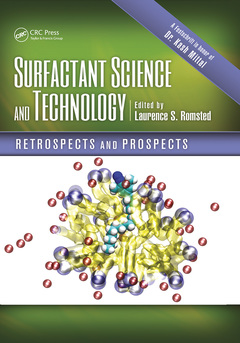Surfactant Science and Technology Retrospects and Prospects
Coordonnateur : Romsted Laurence S.

Surfactant research explores the forces responsible for surfactant assembly and the critical industrial, medical, and personal applications, including viscosity control, microelectronics, drug stabilization, drug delivery, cosmetics, enhanced oil recovery, and foods. Surfactant Science and Technology: Retrospects and Prospects, "a Festschrift in honor of Dr. Kash Mittal," provides a broad perspective with chapters contributed by leaders in the fields of surfactant-based physical, organic, and materials chemistries. Many of the authors participated in a special symposium in Melbourne, Australia, honoring Kash Mittal?s 100th edited book at the 18th Surfactants in Solution (SIS) meeting. Each chapter provides an overview of a specific research area, with discussions on past, present, and future directions.
The book is divided into six parts. Part I reviews the evolution of theoretical models for surfactant self-assembly, and introduces a model for interpreting ion-specific effects on aggregate properties. Part II focuses on interactions of surfactant solutions with solid supports; uses contact angles to understand hydrophobic/hydrophilic changes in a lipid layer; uses surface tension to understand molecular arrangements at interfaces; reviews spreading phenomena; discusses pattern formation on solid surfaces; and applies tensiometry to probe flavor components of espresso. Part III discusses novel DNA-based materials, multifunctional poly(amino acid)s?based graft polymers for drug delivery, and polymeric surfactants for stabilizing suspensions and emulsions.
Part IV introduces farm-based biosurfactants from natural products and "greener" biosurfactants from bacteria. Part V explores lyotropic liquid crystals and their applications in triggered drug release; microemulsion properties and controlled drug release; the role of hydrotopes in formulations and in enhancing solubilization in liquid crystals; the potential of ionic liquids to generate tunable and selective reaction media; and provides an overview of stimuli-responsive surfactants. Focusing on emulsions, Part VI reviews the design of emulsion properties for various commercial applications, the role of surfactants in the oil and gas industries, and surfactant mechanisms for soil removal via microemulsions and emulsification.
Part I Theory of Self-Assembly and Ion-Specific Effects. One Hundred Years of Micelles: Evolution of the Theory of Micellization. Ionic Surfactants and Ion-Specific Effects: Adsorption, Micellization, and Thin Liquid Films. Part II Surfactants at Solid—Liquid Interfaces. Wettability of Solid-Supported Lipid Layers. Surfactant Adsorption Layers at Liquid Interfaces. Wetting and Spreading by Aqueous Surfactant Solutions. Wetting Instabilities in Langmuir–Blodgett Film Deposition. Interfacial Studies of Coffee-Based Beverages: From Flavor Perception to Biofuels. Part III Polymeric Surfactants and Polymer/Surfactant Mixtures. DNA Release from Cross-Linked DNA Gels and DNA Gel Particles. Advances in Poly(Amino Acid)s–Based Amphiphilic Graft Polymers and Their Biomedical Applications. Polymeric Surfactants and Some of Their Applications. Part IV Biosurfactants. Biosurfactants. Microbially Derived Biosurfactants: Sources, Design, and Structure-Property Relationships. Part V Formulation and Application of Surfactant Aggregates. Triggered Drug Release Using Lyotropic Liquid Crystals as Delivery Vehicles. Pharmaceutical Microemulsions and Drug Delivery. Hydrotropes: Structure and Function. Surfactant Ionic Liquids: Potential Structured Reaction Media? Stimuli-Responsive Surfactants: History and Applications. Part VI Formulation and Application of Emulsions. Progress in Designing Emulsion Properties Over a Century: Emerging Phenomenological Guidelines from Generalized Formulation and Prospects to Transmute the Knowledge into Know-How. An Overview of Surfactants in Enhanced Oil Recovery. Soil Removal by Surfactants during Cleaning Processes. Index.
Laurence (Larry) S. Romsted, Ph.D., is a chemistry professor at Rutgers, The State University of New Jersey in Piscataway. He has published 92 papers using physical organic chemistry methods to probe properties of association colloids, and he has given about 90 invited talks at international meetings and another 90 university seminars. In 1991, he published what proved to be a singularly important paper in Accounts of Chemical Research, "Ion Binding and Reactivity at Charged Aqueous Interfaces," that spread the pseudophase model for micellar catalysis to the world.
Date de parution : 12-2021
17.8x25.4 cm
Disponible chez l'éditeur (délai d'approvisionnement : 14 jours).
Prix indicatif 56,31 €
Ajouter au panierDate de parution : 05-2014
Ouvrage de 593 p.
17.8x25.4 cm
Thèmes de Surfactant Science and Technology :
Mots-clés :
Winsor III; Contact Angle; American Chemical Society; Nonionic Surfactants; Alkylbenzene Sulfonates; DNA Release; Winsor II; Spontaneous Imbibition; Ionic Surfactants; Interfacial Tension; Adsorption Isotherm; SAILs; Surfactant Solution; Microemulsion Formulations; Surfactant Molecule; Anionic Surfactants; Aggregation Number; Pharmaceutical Microemulsions; Surfactant Retention; Solid SMEDDS; Trisiloxane Surfactants; Cremophor EL; Ion Specic Effects; Rodlike Micelles; Sodium Xylene Sulfonate



